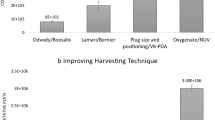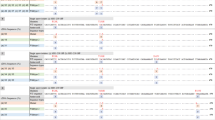Abstract
The generation of single spore isolates is usually the first approach to characterize plant fungal pathogens with respect to their specific resistance mechanisms to fungicides. The isolation procedure can be time-consuming and can carry the risk of contamination, but for fungal species with saprophytic growth (e.g., Zymoseptoria tritici) it is simple to perform in most cases. However, for biotrophic fungi such as Phakopsora pachyrhizi the situation is more difficult. This may be the reason why all published studies on fungicide resistance mechanisms of this fungus have been conducted with populations or monouredinial isolates. Monouredinial isolates, in contrast to single spore isolates, are generated from several spores of one uredinium, and thus, it is not ensured that these isolates are clones and therefore genetically identical. Since only dikaryotic uredospores of P. pachyrhizi have been found in the field so far, the mechanisms of fungicide resistance are more complex than for other pathogens. Therefore, the use of clones as a tool for further characterization is mandatory. We established a reliable method to generate single spore isolates of P. pachyrhizi and demonstrated that the isolates are clonal. For this verification, single spore isolates were used in detached leaf tests (DLTs) and treated with two demethylation inhibitors (DMIs) with different selection pattern. These isolates had different frequency values of three relevant mutations in CYP51. Additionally, a population was included in the DLT that represented a mixture of isolates with the respective CYP51 mutations under the detection limit (< 5%). In contrast to the population in which target site mutations were selected after DMI treatments in an expected manner, the single spore isolates showed no change in their mutation frequencies on untreated or treated leaves. This indicates that these isolates are genetically identical and thus valuable for further elucidation of the complex resistance mechanisms, especially against DMIs, in this fungal species.

Similar content being viewed by others
Availability of data and material
The datasets generated during and/or analyzed during the current study are available from the corresponding author on reasonable request.
References
Bartlett DW, Clough JM, Godwin JR, Hall AA, Hamer M, Parr-Dobrzanski B (2002) The strobilurin fungicides. Pest Manag Sci 58:649–662. https://doi.org/10.1002/ps.520
Bonde M, Nester S, Austin C, Stone C, Frederick RD, Hartman GL, Miles M (2006) Evaluation of virulence of Phakopsora pachyrhizi and P. meibomiae isolates. Plant Dis 90:708–716. https://doi.org/10.1094/PD-90-0708
Christiano R, Scherm H (2007) Quantitative aspects of the spread of asian soybean rust in the southeastern United States, 2005 to 2006. Phytopathology 97:1428–1433. https://doi.org/10.1094/PHYTO-97-11-1428
Darben LM, Yokoyama A, Castanho FM, Lopes-Caitar VS, da Cruz Gallo de Carvalho MC, Godoy CV, et al (2019) Characterization of genetic diversity and pathogenicity of Phakopsora pachyrhizi mono-uredinial isolates collected in Brazil. Eur J Plant Pathol 156:355–372. https://doi.org/10.1007/s10658-019-01872-2
Edwards H, Bonde M (2011) Penetration and establishment of Phakopsora pachyrhizi in soybean leaves as observed by transmission electron microscopy. Phytopathol 101:894–900. https://doi.org/10.1094/PHYTO-09-10-0248
Fraaije B, Cools H, Kim SH, Motteram J, Clark W, Lucas J (2007) A novel substitution I381V in the sterol 14α-demethylase (CYP51) of Mycosphaerella graminicola is differentially selected by azole fungicides. Mol Plant Pathol 8:245–254. https://doi.org/10.1111/j.1364-3703.2007.00388.x
FRAC (2021a) Protocol of the discussions and recommendations of the SBI working group of the fungicide resistance action committee. FRAC. https://www.frac.info/docs/default-source/working-groups/sbi-fungicides/group/minutes-of-the-2021a-sbi-telco-meeting-recommendations-for-2021a-from-3rd-of-march-2021a.pdf?sfvrsn=55f3499a_2. Accessed 10 Dec 2021
FRAC (2021b) Protocol of the discussions and use recommendations of the QoI working group of the fungicide resistance action committee. FRAC. https://www.frac.info/docs/default-source/working-groups/qol-fungicides/qoi-meeting-minutes/minutes-of-the-2021b-qoi-wg-meeting-and-recommendations-for-2021b-(-january-march-2021b).pdf?sfvrsn=28f0499a_2. Accessed 10 Dec 2021
FRAC (2021c) Protocol of the discussions and use recommendations of the SDHI working group of the fungicide resistance action committee. FRAC. https://www.frac.info/docs/default-source/working-groups/sdhi-fungicides/sdhi-meeting-minutes/minutes-of-the-2021c-sdhi-meeting-20-21th-of-january-2021c-with-recommendations-for-2021c.pdf?sfvrsn=66eb499a_2. Accessed 10 Dec 2021
Gisi U, Chin K, Knapova G, Färber RK, Mohr U, Parisi S et al (2000) Recent developments in elucidating modes of resistance to phenylamide, DMI and strobilurin fungicides. Crop Prot 19:863–872. https://doi.org/10.1016/S0261-2194(00)00114-9
Godoy CV, Seixas CDS, Soares RM, Marcelino-Guimarães FC, Meyer MC, Costamilan LM (2016) Asian soybean rust in Brazil: past, present, and future. Pesqui Agropecu Bras 51:407–421. https://doi.org/10.1590/S0100-204X2016000500002
Goellner K, Loehrer M, Langenbach C, Conrath U, Koch E, Schaffrath U (2010) Phakopsora pachyrhizi, the causal agent of asian soybean rust. Mol Plant Pathol 11:169–177. https://doi.org/10.1111/j.1364-3703.2009.00589.x
Grasso V, Palermo S, Sierotzki H, Garibaldi A, Gisi U (2006) Cytochrome b gene structure and consequences for resistance to Qo inhibitor fungicides in plant pathogens. Pest Manag Sci 62:465–472. https://doi.org/10.1002/ps.1236
Hartman GL, Miles MR, Frederick RD (2005) Breeding for resistance to soybean rust. Plant Dis 89:664–666. https://doi.org/10.1094/PD-89-0664
Hartman GL, Miles MR, Frederick RD (2004) Epidemiology and spread of soybean rust. in: American seed trade association conference proceedings, vol 1, no 9
Jørgensen L, Matzen N, Heick T, Havis N, Holdgate S, Clark B et al (2021) Decreasing azole sensitivity of Z. tritici in europe contributes to reduced and varying field efficacy. J Plant Dis Prot 128:287–301. https://doi.org/10.1007/s41348-020-00372-4
Klosowski AC, Brahm L, Stammler G, De Mio LL (2016a) Competitive Fitness of Phakopsora pachyrhizi Isolates with mutations in the CYP51 and CYTB genes. Phytopathology 106:1278–1284. https://doi.org/10.1094/PHYTO-01-16-0008-R
Klosowski AC, May De Mio LL, Miessner S, Rodrigues R, Stammler G (2016b) Detection of the F129L mutation in the cytochrome b gene in Phakopsora pachyrhizi. Pest Manag Sci 72:1211–1215. https://doi.org/10.1002/ps.4099
Klosowski AC, Castellar C, Stammler G, May De Mio L (2018) Fungicide sensitivity and monocyclic parameters related to the Phakopsora pachyrhizi–soybean pathosystem from organic and conventional soybean production systems. Plant Pathol 67:1697–1705. https://doi.org/10.1111/ppa.12883
Kolmer JA, Ordonez ME, Groth JV (2009) The rust fungi. In: John Wiley & Sons, Ltd (eds) Encyclopedia of Life Sciences. Chichester. https://doi.org/10.1002/9780470015902.a0021264
Leroux P, Walker AS (2011) Multiple mechanisms account for resistance to sterol 14α-demethylation inhibitors in field isolates of Mycosphaerella graminicola. Pest Manag Sci 67:44–59. https://doi.org/10.1002/ps.2028
Levy C (2005) Epidemiology and chemical control of soybean rust in southern africa. Plant Dis 89:669–674. https://doi.org/10.1094/PD-89-0669
Loehrer M, Vogel A, Huettel B, Reinhardt R, Benes V, Duplessis S et al (2014) On the current status of Phakopsora pachyrhizi genome sequencing. Front Plant Sci 5:377. https://doi.org/10.3389/fpls.2014.00377
Loehrer M, Panstruga R, Schaffrath U (2016) Untersuchungen zum infektionsmechanismus des asiatischen sojabohnenrostpilzes phakopsora pachyrhizi auf seiner wirtpflanze sojabohne. Dissertation, RWTH Aachen University
Müller MA, Stammler G, May De Mio LL (2021) Multiple resistance to DMI, QoI and SDHI fungicides in field isolates of Phakopsora pachyrhizi. Crop Prot. https://doi.org/10.1016/j.cropro.2021.105618
Ono Y, Buriticá P, Hennen JF (1992) Delimitation of Phakopsora, Physopella and Cerotelium and their species on Leguminosae. Mycol Res 96:825–850. https://doi.org/10.1016/S0953-7562(09)81029-0
Pham T, Miles M, Frederick RD, Hill C, Hartman G (2009) Differential responses of resistant soybean entries to isolates of Phakopsora pachyrhizi. Plant Dis 93:224–228. https://doi.org/10.1094/PDIS-93-3-0224
Saksirirat W, Hoppe HH (1991) Teliospore germination of soybean rust fungus (Phakopsora pachyrhizi Syd.). J Phytopathol 132:339–342. https://doi.org/10.1111/j.1439-0434.1991.tb00129.x
Schmitz HK, Stammler G (2012) Effects of long-term storage methods on the infectivity of urediospores of Phakopsora pachyrhizi. J Phytopathol 160:500–550. https://doi.org/10.1111/j.1439-0434.2012.01927.x
Schmitz HK, Medeiros CA, Craig IR, Stammler G (2014) Sensitivity of Phakopsora pachyrhizi towards quinone-outside-inhibitors and demethylation-inhibitors, and corresponding resistance mechanisms. Pest Manag Sci 70:378–388. https://doi.org/10.1002/ps.3562
Schneider R, Hollier C, Whitam H, Palm M, McKemy J, Hernandez J et al (2005) First report of soybean rust caused by Phakopsora pachyrhizi in the continental united states. Plant Dis 89:774–774. https://doi.org/10.1094/PD-89-0774A
Simões K, Hawlik A, Rehfus A, Gava F, Stammler G (2017) First detection of a SDH variant with reduced SDHI sensitivity in Phakopsora pachyrhizi. J Plant Dis Prot 125:21–26. https://doi.org/10.1007/s41348-017-0117-5
Stammler G, Carstensen M, Koch A, Semar M, Strobel D, Schlehuber S (2008) Frequency of different CYP51-haplotypes of Mycosphaerella graminicola and their impact on epoxiconazole-sensitivity and-field efficacy. Crop Prot 27:1448–1456. https://doi.org/10.1016/j.cropro.2008.07.007
Xiong Li, Shen Y-Q, Jiang L-N, Zhu X-L, Yang W-C, Huang W, Yang G-F (2015) Succinate dehydrogenase: an ideal target for fungicide discovery. In: Maienfisch P, Stevenson TM (eds) discovery and synthesis of crop protection products. American Chemical Society, Washington, DC, pp 175–194. https://doi.org/10.1021/bk-2015-1204.ch013
Yorinori J, Paiva W, Frederick RD, Costamilan L, Bertagnolli P, Hartman G et al (2005) Epidemics of soybean rust (Phakopsora pachyrhizi) in Brazil and Paraguay from 2001 to 2003. Plant Dis 89:675–677. https://doi.org/10.1094/PD-89-0675
Acknowledgements
The authors thank Angelika Hawlik (BASF SE) for her technical assistance, Egon Blaich from BASF Paraguay for providing samples with ASR and John Speakman for critical proofreading.
Author information
Authors and Affiliations
Contributions
All authors contributed in a comparable extend to the manuscript.
Corresponding author
Ethics declarations
Conflict of interest
The authors declare that they have no conflict of interest.
Additional information
Publisher's Note
Springer Nature remains neutral with regard to jurisdictional claims in published maps and institutional affiliations.
Rights and permissions
About this article
Cite this article
Stilgenbauer, S., Steiner, U. & Stammler, G. Generating single spore isolates of Phakopsora pachyrhizi for a better understanding of fungicide resistance mechanisms. J Plant Dis Prot 129, 1063–1071 (2022). https://doi.org/10.1007/s41348-022-00606-7
Received:
Accepted:
Published:
Issue Date:
DOI: https://doi.org/10.1007/s41348-022-00606-7




